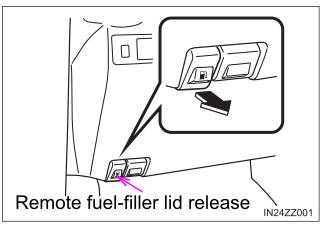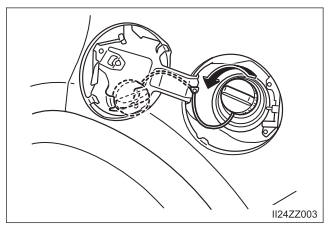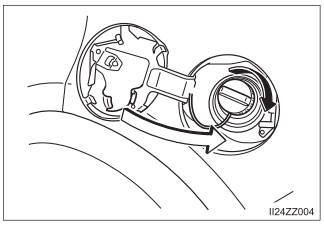Toyota Yaris: Fuel-Filler Lid and Cap / Refueling
Before refueling, close all the doors, windows, and the liftgate/trunk lid, and switch the ignition OFF.
- To open the fuel-filler lid, pull
the remote fuel-filler lid release.

- To remove the fuel-filler cap, turn it counterclockwise.
- Attach the removed cap to the
inner side of the fuel-filler lid.

- Insert the refueling nozzle all the way and begin refueling. Pull out the refueling nozzle after the refueling stops automatically.
- To close the fuel-filler cap, turn it clockwise until a click is heard.
- To close, press the fuel-filler lid until it locks
securely.

 Fuel-Filler Lid and Cap
Fuel-Filler Lid and Cap
WARNING
When removing the fuel-filler cap, loosen the cap slightly and wait
for
any hissing to stop, then remove it
Fuel spray is dangerous. Fuel can burn skin and eyes and cause illness
if
ingested...
 Fuel-Filler Cap
Fuel-Filler Cap
OpenTo remove the fuel-filler cap, turn it
counterclockwise. Attach the
removed cap to the inner side of
the fuel lid.
CloseTo close the fuel-filler cap, turn it
clockwise until a click is heard...
Other information:
Toyota Yaris XP210 (2020-2025) Owner's Manual: Declaration of Conformity
K..
Toyota Yaris XP210 (2020-2025) Owner's Manual: Locking, Unlocking with Auxiliary Key
Turn the auxiliary key toward the front to lock, toward the back to unlock. Lock Unlock To lock All doors and the liftgate lock automatically when the driver’s door is locked using the auxiliary key. To unlock The driver’s door unlocks when the auxiliary key is turned briefly to the unlock position and then immediately returned to the center position...
Categories
- Manuals Home
- Toyota Yaris Owners Manual
- Toyota Yaris Service Manual
- Key Battery Replacement
- How to connect USB port/Auxiliary jack
- Engine & Hybrid System
- New on site
- Most important about car
Break-In Period
No special break-in is necessary, but a few precautions in the first 600 miles (1,000 km) may add to the performance, economy, and life of the vehicle.
Do not race the engine. Do not maintain one constant speed, either slow or fast, for a long period of time. Do not drive constantly at full-throttle or high engine rpm for extended periods of time. Avoid unnecessary hard stops. Avoid full-throttle starts.
Copyright © 2025 www.toyaris4.com
